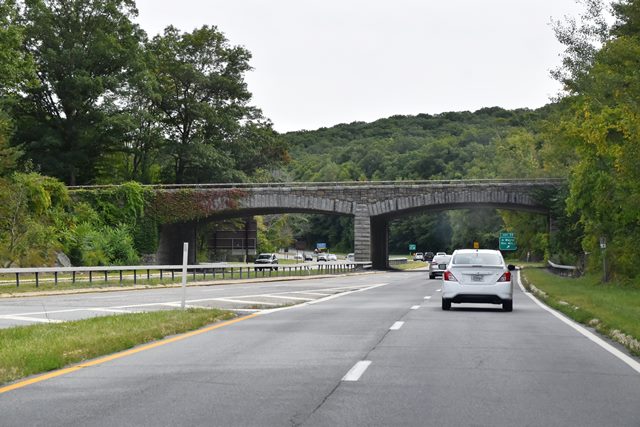We Recommend:
Bach Steel - Experts at historic truss bridge restoration.
BridgeHunter.com Phase 1 is released to the public! - Visit Now
Anthony Wayne Drive Bridge

Primary Photographer(s): Nathan Holth
Bridge Documented: September 2, 2019 and September 5, 2019
Anthony Wayne Drive Over Palisades Interstate Parkway (NY-987C)
Rural: Orange County, New York: United States
Not Available or Not Applicable
64.0 Feet (19.5 Meters)
139.0 Feet (42.4 Meters)
34 Feet (10.36 Meters)
2 Main Span(s)
1068780

View Information About HSR Ratings
Bridge Documentation
View Archived National Bridge Inventory Report - Has Additional Details and Evaluation
About This Bridge's Photo-Documentation
This expressway overpass bridge was photographed by HistoricBridges.org while driving on the associated highway. As such, only overview photos from the expressway lanes are available. Although the many old overpasses on New York State parkways are similar in design and appearance, there is a lot more variety in design and aesthetic details than on modern overpass bridges. Providing a full HistoricBridges.org style detail-oriented photo-documentation is not feasible due to cost and time. However, these photos are intended to generally document the parkway and the design of the bridge. The parkway and its bridges are historically significant as documenting the earliest attempts to provide a limited access highway system to facilitate the rapid movement of large volumes of traffic.
About New York State Parkways
In the early 20th century as motor vehicles rapidly grew in popularity and population, the need to provide more efficient roads became clear rather quickly. One of the early efforts to this effect was the development of limited access highways, the earliest forms of what would eventually evolve into modern expressways and interstate highways. These early roads were often called parkways, although the term superhighway was sometimes used too. Like modern expressways these roads had grade crossings separated by overpass bridges, and access was typically limited to ramps provided at some crossings. However, compared to modern expressways, the design speeds were much lower, travel lanes were narrow, and overpasses were not usually designed with clearance suitable for modern trucks. Also, as the name implies, these "parkways" were designed with a much higher level of attention given to beauty including in bridge design, as well as landscaping (trees in the medians for example). Overpass bridges in the greater New York City region and elsewhere in New York State typically used concrete rigid-frame or concrete arch bridges faced in stone. This choice of structure type matches many other parkways built in the United States in this period. The use of rigid-frame and concrete arch bridges for limited access highway overpasses tends to appear on only the oldest of freeways, because the design was not economical for the longer spans employed on more modern freeway systems.
In New York State many of the parkways are associated with Robert Moses.
![]()
Photo Galleries and Videos: Anthony Wayne Drive Bridge
Bridge Photo-Documentation
Original / Full Size PhotosA collection of overview and detail photos. This gallery offers photos in the highest available resolution and file size in a touch-friendly popup viewer.
Alternatively, Browse Without Using Viewer
![]()
Bridge Photo-Documentation
Mobile Optimized PhotosA collection of overview and detail photos. This gallery features data-friendly, fast-loading photos in a touch-friendly popup viewer.
Alternatively, Browse Without Using Viewer
![]()
Maps and Links: Anthony Wayne Drive Bridge
Coordinates (Latitude, Longitude):
Search For Additional Bridge Listings:
Bridgehunter.com: View listed bridges within 0.5 miles (0.8 kilometers) of this bridge.
Bridgehunter.com: View listed bridges within 10 miles (16 kilometers) of this bridge.
Additional Maps:
Google Streetview (If Available)
GeoHack (Additional Links and Coordinates)
Apple Maps (Via DuckDuckGo Search)
Apple Maps (Apple devices only)
Android: Open Location In Your Map or GPS App
Flickr Gallery (Find Nearby Photos)
Wikimedia Commons (Find Nearby Photos)
Directions Via Sygic For Android
Directions Via Sygic For iOS and Android Dolphin Browser
USGS National Map (United States Only)
Historical USGS Topo Maps (United States Only)
Historic Aerials (United States Only)
CalTopo Maps (United States Only)

